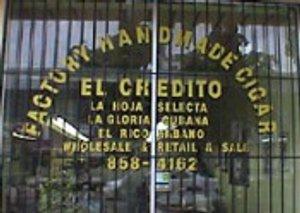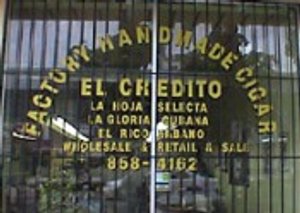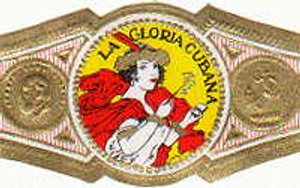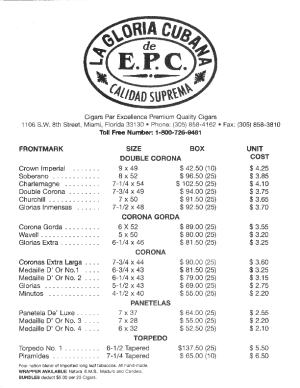Cigarticles
Cigarticle: The Glory Days of La Gloria Cubana

When people think of rare and hard to find cigars, they often think of the special Arturo Fuente offerings. But a few years back there was another smaller brand that developed a cult-like following. For a couple of years in the nineties, one entire regular line of Ernesto Perez-Carrillo's Florida-based El Credito cigar factory was more elusive and prized than probably any other standard brand. Looking back to the peak of the cigar boom, I think the La Gloria Cubana cigar marque has one of the quirkiest histories out there.

First, in the fall of 1992 and the winter of 1993, a relatively new magazine, Cigar Aficionado, rated the La Gloria Cubana Wavell very highly and printed a feature story about the El Credito operation in the magazine. Cigar Aficionado was just becoming influential in the cigar world, and that cycle of publicity jump-started the popularity of the La Gloria Cubana brand. On the heels of those issues, orders increased from the hundreds of cigars to the thousands. Shortly after that happened, conservative talk radio host Rush Limbaugh, on his wildly popular daily radio show, named La Gloria Cubana as one of his favorite cigars. At that point the buzz really took off.

You could buy cedar boxes of La Gloria Cubana if you could find them, but since there was a Spanish cedar shortage during the boom, boxes were hard for Ernesto to come by. As a partial answer to the problem he made it $5 cheaper to buy the cigars in cellophane bundles. Naturally there was spirited discussion regarding the potential differences between the cigars in the two types of packaging. Some thought that the best cigars were selected for boxing, others held that it made no difference. In any case, finding a bundle of LGCs on the shelf of a tobacconist was a major score!
Throughout the treasure hunt, El Credito continued to sell La Gloria Cubana directly from the factory. Buyers could call the El Credito factory on 8th Avenue in Calle Ocho and request a fax copy of the price list and the fax number to which they would send orders. El Credito had no web site and, frankly, could barely handle the volume of phone calls; many calls would go unanswered. As I recall, someone unrelated scanned a price list and posted it on the web in .pcx format and others would refer people to that site.

Calling on the phone first thing in the morning sometimes bore fruit, but you'd have to deal with one of the least friendly women on the planet to place an order. To be fair, the women answering the phones were not clerical workers, they were actual factory employees and were not all that happy to be answering the phone, and the attitude showed. In fact, for a while Elena, one of the ladies, got the nickname of Cigar Nazi after the famous Seinfeld episode about the Soup Nazi! A typical conversation would go like this: "What do you want? No, we don't have those." Click.
Legend has it that during LHCT 2 in January of 1998, one of the crawlers visited the El Credito factory the day before the official tour. Approaching the counter, he requested maduro Wavells. When Elena asked how many boxes he wanted, the crawler reportedly asked how many they had, and then bought them all. The next day the rest of the group was depressed that there were no Wavells in the factory, and when Ernesto arrived during the visit driving a pickup truck full of cartons of fresh La Gloria Cubana cigars, the cheer the group let out could be heard for blocks.
LGC was also one of the first cigars to suffer from the "sick period" that is largely responsible for the aging fanaticism seen today. Prior to the boom, most Cuban and premium cigars were aged at the factory, so personal aging of premiums to increase quality and flavor was a pretty rare occurrence for the casual smoker. LGCs were shipped fresh from the roller's table, so you either smoked them right away or you had to wait six months for the secondary fermentation to take place. During that six month period the cigars smelled like Mr. Clean because of the ammonia.
Another peccadillo of La Gloria Cubana was the maduro/natural sorting. Maduro cigars were just really coming into vogue in the mid 90s and the maduro Wavell was the hottest ticket in town. The rollers at El Credito would select the darkest wrapper leaf available each day, and that would be used for the maduros produced during that shift. Since the color of wrapper fluctuated wildly during the boom, maduros made one day could be several shades lighter than the naturals made the next. It was strictly luck of the draw in that regard.
La Gloria Cubana is not the only cigar produced by El Credito. At various times El Credito has made the flagship line of La Gloria Cubana, the stronger El Rico Habano, a milder blend called Dos Gonzales, and another mild Dominican cigar, La Hoja Selecta. There is also a line of seconds or mixed filler cigars using the same blend as La Gloria Cubana that are called, appropriately enough, El Creditos.
In 1996, having maxed out production in the Miami facility, El Credito began rolling additional cigars in a new factory in the Dominican Republic. According to Ernesto both factories were supplied with exactly the same tobacco and Ernesto swore that the blend between the two facilities was identical, but a raging debate soon started as to which country made the best cigars. Many felt that the younger, less experienced rollers in the D.R. just didn't create the same quality product as that being made in Miami. Despite several blind tests which seemed to indicate that there is no discernible difference in quality or flavor, that debate lasts to this day. It's important to note that production costs in Miami are such that it's a wonder, and a testament to Ernesto's loyalty to his employees, that any are still rolled there.
Today El Credito is part of the large General Cigar Corporation and La Gloria Cubana is a very large and well-respected brand. Still produced under the supervision of Ernesto Perez-Carrillo, the La Gloria Cubana line lives up to its interesting and storied past.

Roger Farnsworth (ElkTwin) is a husband, father, globally recognized marketing sage and erstwhile gentleman rancher with a slightly irreverant view of life. Roger has enjoyed cigars on six continents and in 18 time zones. His musings on technology can occasionally be found in respected periodicals and trade journals.